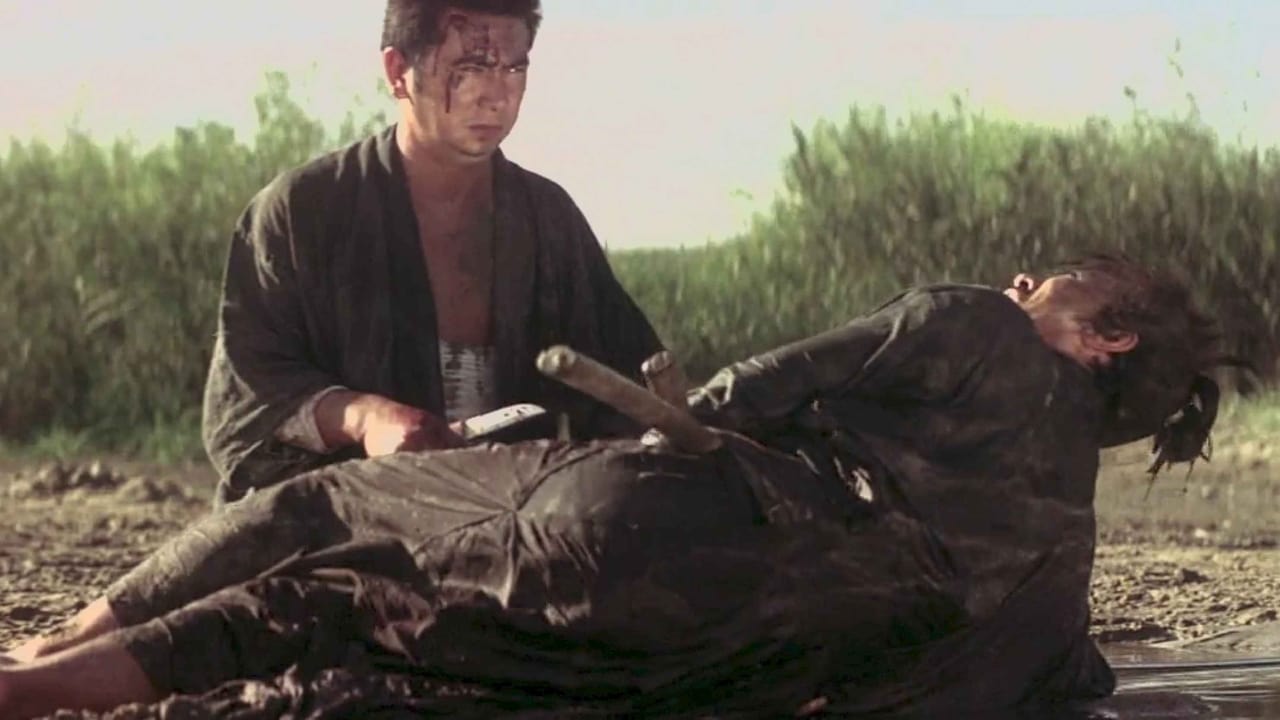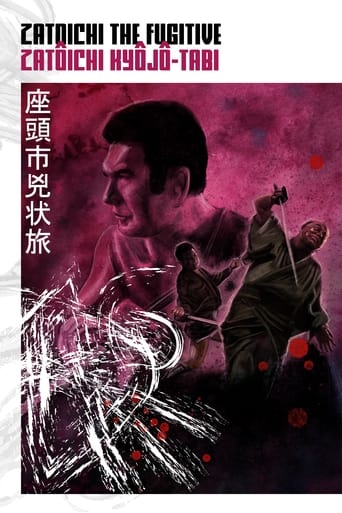


Zatoichi, the Fugitive is the fourth entry in the franchise and the second film to be shot in color. It's the second of three films released within the same year. The movie starts with Zatoichi being attacked by an inexperienced yakuza who wants to earn the bounty on Zatoichi's head. Zatoichi easily kills his opponent and wants to find out who wants to pay the reward for seeing him dead. The blind masseur travels to a nearby town where he confesses to the bounty hunter's mother that he killed her son. While the mother pardons Zatoichi, a group of samurai wants to avenge the bounty hunter's death. As if that weren't enough, Zatoichi also has to deal with the weak inheritor of a local yakuza who seeks Zatoichi's help but who is also pressured to kill Zatoichi by his peers to prove his strength. In addition to this, Zatoichi meets Otane again, a woman he carried passionate feelings for in the first two films. He realizes she is unhappily married to a quick-tempered ronin and decides to challenge him. Soon, Zatoichi has to face a group of vindictive samurai, a mean ronin and an untrustworthy inheritor all at once.The main problem with this film is that the plot is at times tough to follow with its numerous characters. It's not always clear why and when the inheritor changes his mind and is Zatoichi's partner, just to become his opponent and to end up supporting him once again. The numerous yakuza bosses and their motives for wanting Zatoichi dead are also quite confusing. Even the return of Otane is somewhat strange as she seems to be torn between Zatoichi and her husband. In one scene, she almost romantically walks around with Zatoichi and opens up to him about how her life has changed for the worse and the next day she apparently tries to trick him in order to kill him and get the bounty on his head. The movie would have been much more enjoyable with less characters who have clearer objectives. This film's epic proportions made me feel lost at times.On the positive side, the wild Japanese landscapes and colourful towns are still fascinating to watch and especially the abandoned house in the meadows where the final showdown happens is a gorgeous location. The final fight sequences are beautifully and cleverly choreographed. The entertaining last twenty minutes save the movie from being just average or worse.In the end, Zatoichi, the Fugitive is the weakest film of the franchise so far but it's saved by a fast-paced closing twenty minutes and the charming use of traditional rural Japanese locations. Fans and followers of the franchise can give this film a try but occasional fans of Chanbara or samurai films can skip this entry without any regrets.
... View MoreZatoichi the Fugitive is the fourth Zatoichi film and the second one in a row directed by Tokuzo Tanaka. I must say I didn't really like this one. It's kinda forgettable and blends in with the previous film for me even though the storyline is quite different.The story to this movie was really complicated for me to follow and I quick lost track on who is who. Not only that, but the pace was too slow for my taste this time, so I didn't enjoy following the goings-on here at all. The movie gets significantly better during the final fight scene of Zatoichi vs. a group of nameless thugs, and the final duel with the main villain, and this particular scene looks like it just came out of a Sergio Leone film. Tane (from the first two films) re-appears, and personally I don't really like that the series is still burdened by continuity; I'd rather see Zatoichi meet new people and all. The score by Akira Ifukube (who also scored Godzilla) is really good and fits in nicely, and the cinematography (done by the same person who shot the previous film, Chishi Makiura) is once again really nice and the shots are a pleasure to look at. I especially like the way the actors look when captured on this particular type of color film, the way their faces are pale and covered in plenty of dark shadows.Highlight of the film: the villain threatens Zatoichi by cutting a sake bottle in half with his blade. Zatoichi responds by perfectly throwing a dice into the second sake bottle (which some guy is holding), then swings his katana in the air. The guy drops the bottle, which is revealed to be bisected in half, same as the dice that was inside it.
... View MoreOne might mistake this for the first Zatôichi in colour, so bold are the colours during the opening credits that they'd challenge even Imamura's hyper-lush "Kamigami no yakubo" (1968). What the films achieve wonderfully is that they still allow the necessary plotting to take its time. In modern fare I think we'd be having all the quiet moments and hesitations removed, let alone all the human drama. Thus the film really has genuinely suspenseful moments and genuine drama. Otane reappears, and we are allowed to see a loose end tied in the drama. I'm going through the films in chronological order just now. It will be interesting to see where the series goes as it matures; these early films have all been very brilliant.
... View MoreMASSEUR ICHI, THE FUGITIVE (1963) is the fourth in the series of Japanese swordplay films devoted to the exploits of Zatoichi, the blind swordsman whose super-hearing and sensitivity enabled him to perform impressive feats of derring-do. This entry is somewhat slower-paced and less action-packed than would become the norm in later Zatoichi films (which would continue to be produced through 1973). There is only one major swordfight, near the very end, but at least it's a spectacular one, with Zatoichi (Shintaro Katsu) slashing opponents right, left, front and back, although the spurting bloodshed which would soon become a distinct feature of samurai films is noticeably absent here. Zatoichi himself is also considerably less superhuman than he appears in later films.Instead, the emphasis is Zatoichi's role as mediator in a conflict between gang bosses in a town he is visiting solely to pay respects to the mother of a gang member he'd killed who'd been seeking the ten gold coin bounty on Zatoichi's head. The complex interrelationships among the characters center chiefly around two young women, one of them a former lover of Zatoichi's who is now the wife of a sword-for-hire seeking to sell his services to one of the wily bosses. Zatoichi sides with the underdog, Sakichi, who'd reluctantly inherited his father's territory but would rather marry the other young woman, Onobu (Miwa Takada), the pretty young daughter of the innkeeper, a once-powerful gang boss bearing a powerful grudge because he'd lost his territory to Sakichi's father. The gang bosses pressure the vulnerable Sakichi to use Zatoichi's trust to set a trap for him. The stage is then set for a series of confrontations that culminate in the final battle.It may be slow going for most action and swordplay buffs, but it has a formal beauty that later films in the series dispensed with in favor of more visceral thrills. The polished camerawork, largely on location, gives us stately compositions focused on the characters and their relationships. A sparing score by venerated composer Akira Ifukube adds a touch of class. Samurai films of the time routinely boasted such visual and aural elegance long before the audience demanded more bloodshed and a more excessive approach in later films (see, especially, the "Lone Wolf and Cub" series).
... View More